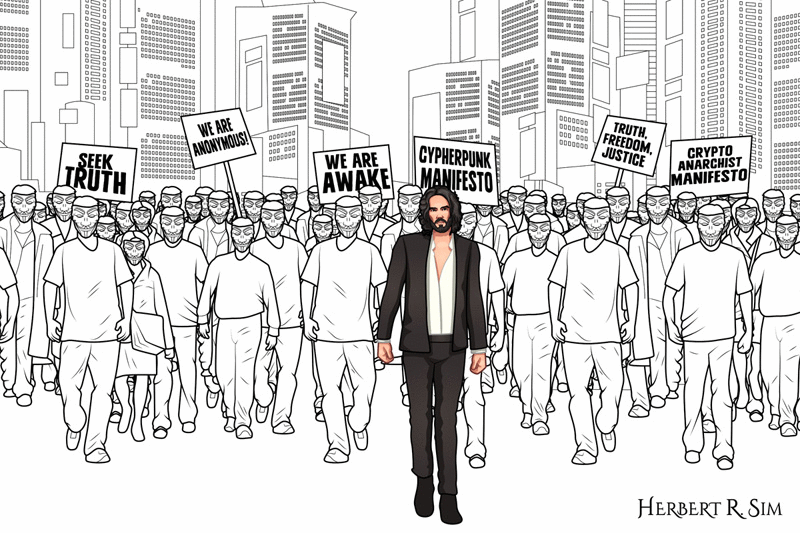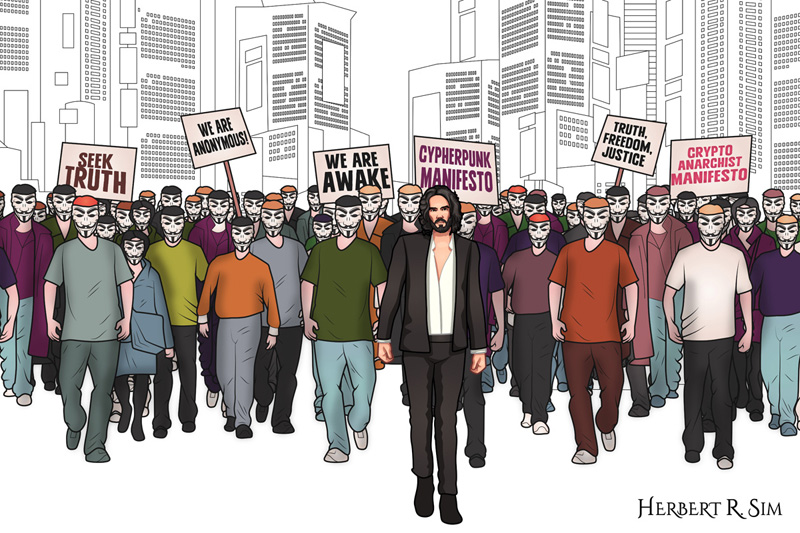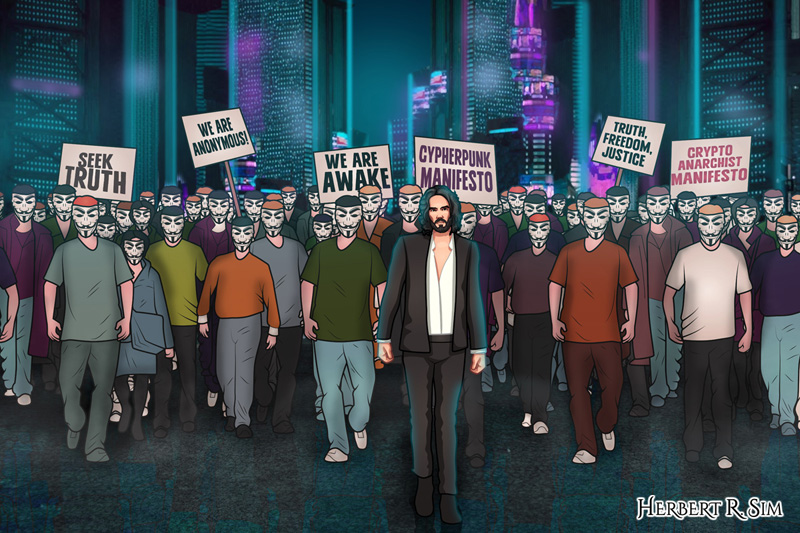
Above is my sketch of the Million Mask March, with Russell Brand at the forefront leading the pack. “We are Anonymous. We are Legion. We do not forgive. We do not forget. Expect us.” — Anonymous (匿名者)
———————————————————-
It was just a couple weeks ago that demonstrations in more than 400 cities had been planned as part of the event – billed as the “Million Mask March” – that coincided with Guy Fawkes Day.
Protesters wearing the white-faced Guy Fawkes masks that have become synonymous with the Occupy movement and the hacktivist grouping Anonymous have taken part in hundreds of gatherings around the world in opposition to causes such as corruption.
One of the largest protests of Tuesday night took place in central London, where the comedian and advocate of “complete revolution” Russell Brand was pictured among crowds of people wearing a Guy Fawkes mask.
One of a number of Facebook pages for the event described it as a “Call for Anonymous, WikiLeaks, the Pirate Party, Occupy and Oath Keepers to defend humanity”. It also added “Remember who your enemies are: billionaires who own banks and corporations who corrupt politicians who enslave the people in injustice.”
I believe that the introduction of Bitcoin is the first procedure in a greater transition to an “anarcho-capitalist society”. The digital currency would be an interesting experiment where its long-run success could revolutionize both the money system and how the governance should operate.
Once Bitcoin achieves success, I believe that the next step to a more significant change could then be planned and implemented. An “anarcho-capitalist society” will be formed more readily if software agents start replacing the current functionalities and services provided by centralized parties such as the government.
People should generally start investing in education, an aspect that has been neglected for too long, thus the founding of Crypto Chain University in 2010, to compile blockchain and cryptocurrency research papers, and making it decentralized, open-source, free-for-all to tap into the knowledge base.
Investors should put in efforts to obtain knowledge and do research by themselves in the crypto sector and crypto developers should also aid users by providing the required knowledge to operate certain software and hardware.
Timothy C. May, Cypherpunk (数码朋克) wrote in his “Crypto Anarchist Manifesto” that the usage of crypto allows the formation of a system which allow its users to interact with each other directly without the influence of the government.
May also criticized that crypto should be treated to be just another form of payment such as PayPal or Visa but should be seen as something entirely different. He further commented that the main uses of cryptocurrencies would be eliminated once the government attempts to regulate and restrict the market even more.
However, it is difficult to convince the government not to regulate the market, as crypto has undoubtedly become a tool exploited by criminals. If regulatory actions are not taken by the government, crypto would soon become the ultimate nest for motivated criminals for illegal activities.

“The corrupt fear us. The honest support us. The heroic join us.” — Anonymous
———————————————————-
Cyberspace, Crypto Anarchy, and Pushing Limits
Written by Timothy C. May on 3 Apr 1994.
This messages touches on two topics of recent interest (to some) here:
Setting up payment systems for message transmission, to handle the issues of “mailbombing” and “flooding” in a more natural way (locality of reference, user of a service pays, avoidance of the “Morris Worm” explosion effects which could’ve happened with Detweiler bombed us, as Hal noted).
The general issue of “Cyberspace.” This lies at the root of some recent disagreements here, and is worthy of more discussion. Crypto will make this a very real cusp issue in the next several years.
Why debate it now? What could possibly come out of such a debate?
It happens that I’m reading a wonderful new book by Kip Thorne, entitled “Black Holes and Space Warps.” This is widely available in bookstores, in hardback only at this time. ($30, but it’s a whopping big book, and I got it at Barnes and Noble for $24. Speaking of Barnes and Noble, the Santa Clara store is selling Li and Vitanyi’s “Intro. to Kolmogorov Complexity” book for $44, before the 20% hardback discount, which may be a mispricingm, as I paid $60 for mine. Check it out if you’re interested….I think there were two copies.)
Thorne has spent 30 years studying gravitational collapse and black holes, and was a coauthor of the famed 1973 book on “Gravitation,” which I got to use in a Xeroxed form for my general relativity class in 1973.
The point? Thorne describes his involvement with Carl Sagan in working out the physics of time travel via wormholes. Thorne had an epiphany: however unlikely the engineering or financing of something is, there is something valuable to be gained in examining the absolute limits of what is possible without regard for engineering practicalities. Thus, he and his students looked into the implications of an extremely advanced civilization able to somehow hold open the mouth of a wormhole. The conclusions are fascinating and led to a new line of thinking about the structure of space-time.
Pushing limits and seeing “ideal” behavior is invigorating.
The connection to crypto is this: Perhaps we should be thinking more about the implicaitons and effects of strong crypto, digital money, ideal remailers, etc., assuming that certain practical problems that bedevil us today are, or soon will be, solved. To some extent we already do this, as when we discuss Chaum’s ideal mixes in the same way engineer’s discuss ideal op amps–a useful abstraction of behavior in the limit that lesser, real world implementations can then be contrasted with.
And of course many of us have found Vernor Vinge’s “True Names” to be an excellent (and quickly readable) treatment of how things could work in a world of fast, cheap, and secure communication. Other writers have seen things differently (e.g., “Shockwave Rider,” “1984,” “Snow Crash”).
Here, to cut to the chase, are some brief statements of what I see as the “behavior in the limits.” I won’t elaborate on them right now.
———————————————————-

Notice the banners “Seek Truth”, “We Are Anonymous”, “We Are Awake”, “CypherPunk Manifesto” (密码朋克宣言), “Truth, Freedom, Justice”, Crypto Anarchist Manifesto”.
———————————————————-
- “Pay as you go” is the natural way to handle most economic transactions. There are exceptions, of course, such as insurance, contracts for future perfomance, etc., but for the most part money is used to mediate immediate exchanges. For a timely example, why can your enemies not “junk mail bomb” you with truly large (tons) of junk mail? Junk mail, as we call it, is in relatively small volumes (at most a mailbox full, except for celebrities perhaps) because of one simple thing: someone has to pay for the delivery! There is no possibility of a “free” way to “Make 19 copies of this ton of garbabe and mail them to your enemies.” That there is with software–the remailer bombing by Detweiler, the 1988 Morris Worm, the “Dave Rhodes” chain letters–is due to some flaws in the current Net model:
- costs of message trasnmission are not directly borne by senders (encourage overuse by some of scarce resources, a la the “tragedy of the commons”).
- sites and remailers will respond to “instructions” to send the message on, to make copies of it, etc.
- I thus consider it imperative that we develop as quickly as we can the following:
- payment systems for message transmission (I’ve argued for “digital postage” as a first and comparatively easy application of digital money, others have as well, and Ray Cromwell just today issued his own proposal….time we get going on this. And lest you think I’m calling for altruism here, I think some fortunes will be made in this area.)
- anonymous or identity-obscuring protocols, a la Chaum.
- a general move away from “commons”-oriented systems, which breed the notions of “fair access” and such. If the “problem” is that poor people cannot–it is alleged–afford a $17 a month Net connection (what Netcom charges, in about 25 cities and growing), then my solution would be to simply subsidize their bill. (I’m not advocating this, nor do I think it wise to subsidize anyone’s phone, Net, or dinner bills, but better this than “nationalizing” networks and thus creating more confusion and less efficiency for all.)
- Connectivity will be altered dramatically, The “distance” in cyberspace is already uncorrelated to physical distance. (Hardly surprising, as this was apparent with the telephone. But a useful way of looking at cyberspace, as being a space of radically altered connectivities and distances.)
- Local access to service, the phone or cable lines that reach the home or office, is a potential bottleneck. But once a connection is made to a local node where multiple competitors exist (that is, once beyond the local government-granted monopoly), the possibility of “censorship” decreases rapidly, for several reasons.
- thus, push for “encrypted access” lines from a terminal node (home, office) to a point with unlimited connectivity.
- this is the situation I now have with my PacBell line and Netcom: PacBell doesn’t “care” what I use the local line for, and once outside, I can dial a less-censorious Netcom rather than a Big Brotherish AOL or Prodigy.
- Cyberspace is infinitely colonizable. No limits to growth. (Assumption: realization of cyberspace is on various machines and networks, which are not free, nor infinite. But the “no limits” comes from ease with which those near a “boundary” can simply push out that boundary with more CPU resource, more networks, etc.).
- Crypto means access to “regions” can be controlled by “owners”:
- “my house, my rules” enforced locally, without central State authority
- essentially unbreakable security (in crypto sense)
- By the way, strong crypto is the “building material” of cyberspace…the mortar, the bricks, the support beams, the walls. Nothing else can provide the “permanence”…without crypto, the walls are subject to collapse at the first touch by a malicious person or agency. With crypto, not even a 100 megaton H-bomb can breach the walls.
(If you think I’m exaggerating, do some calculations on the energy to break a 1000-decimal-digit modulus.) - No “zoning laws” will be needed, or possible, in cyberspace. (Neil Stephenson’s “Snow Crash,” while a wonderful and thought-provoking read, got it wrong here: cyberspace is too extensible and locally controllable.)
- Physical location of cyberspace locations will be increasingly hard to pin down. A vast “labyrinth of rooms and corridors” might be physically instantiated on a computer in Malaysia, while a “virtual gambling hall” is being run via cryptographic cutouts (remailers) from someone’s bedroom in Provo, Utah.
- The talk about “access rules” is thus shown to be meaningless, unless the governments crack down on networks, crypto, and private systems in a way far beyond anything now being talked about.
This is the “crypto anarchy” I have been writing about since 1988. Cyberspace will turn out to be a far vaster frontier than anything we have seen so far. With “only” 10^70 or so particles in the entire universe, there’s vastly more “space” (address space, key space, etc.) in even a relatively small set of digits. Cyberspace is mathematical space, and its spaciousness is truly unlimited.
And we’ll be moving our trade, our entertainment, and much of our lives into cyberspace a whole lot faster than we’ll be slowly moving into low Earth orbit and beyond. In fact, I consider that I’m already half-way in. In a few years, with Mosaic-like one-touch connectivity, with a plethora of network choices, with secure remailers and similar tools to anonymize my transactions, I’ll be so far in there’ll be turning back.
Enough for these remarks right now. I think it makes sense to take a slightly longer-range view of the inevitable trends, to see where we’re going, to see what issues need more work.
I hope some of you agree with me.
–Tim May
———————————————————-

